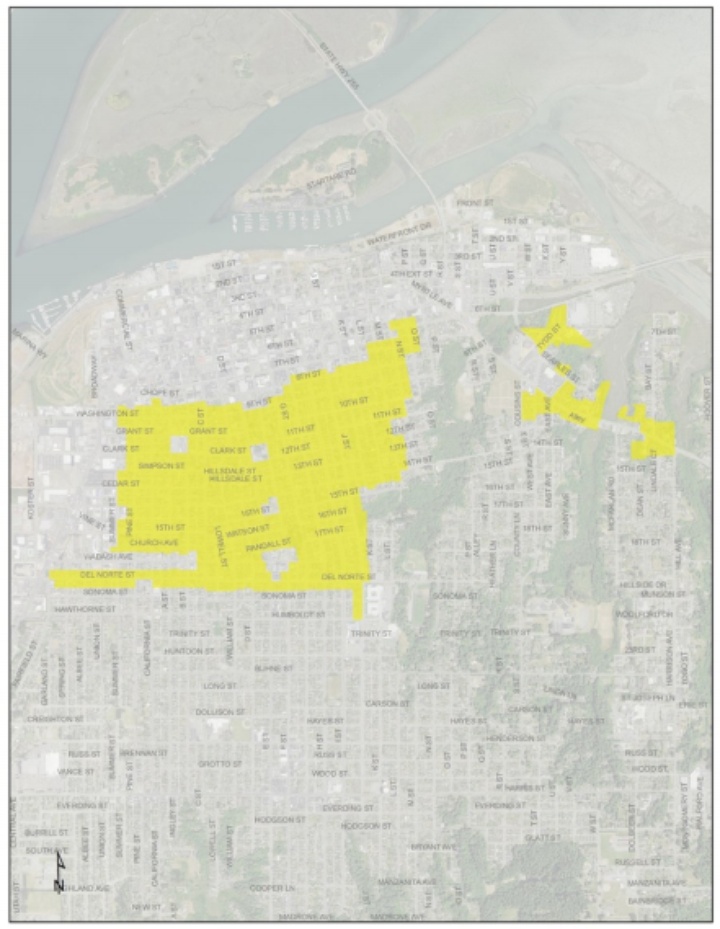Last month we at LoCO were amused to discover, via the City of Eureka’s monthly newsletter, that staff was launching a 14-part series on municipal land use called “Get to Know a Zone District.”
“What a delightful juxtaposition of the playful and mundane!” we said to ourselves.
Our joy only increased upon reading the thing. (If you haven’t yet, we recommend it highly. CLICK HERE.) The unnamed Planning Division staffer who’s writing this series has a knack for making wonky policy concepts accessible, and an equivalent skill in crafting witty deadpan dialog. (The feature, written in Q&A format, is peppered with oddly specific details that suggest real characters in conversation.)
In this week’s installment, a discussion about multifamily residential zones meanders into such topics as Greek v. Latin prefixes and “granny flats” before the inquisitor reveals his totally bizarre occupation.
Enjoy!
RM-1000 zone districts in Eureka. | Image courtesy City of Eureka.
Welcome to the second installment of our fourteen part series “Get to Know a Zone District.” In this series, a staff-member in the Planning Division (the same one) answers questions about each Zoning District in the City. This month we will be exploring our full-on multifamily residential zone: RM-1000
1. What is RM-1000? What does it stand for?
Great question. The “RM” stands for “Residential Multi-Family”. The 1000 refers to the minimum lot area required per housing unit that can be built on the lot in excess of the first four.
2. The first four? What does that mean?
For a standard-sized lot (6,000 square feet), the starting point is four housing units – right out of the gate. For every additional 1,000 s.f. of lot area you get to have one more housing unit. For example, a 7,000 s.f. lot would get to have 5 housing units (4 + 1). An 8,000 s.f. lot would get to have 6 housing units (4 +2). Almost everybody is good for at least a quadplex.
3. Quadplex? Do you mean fourplex?
No, I mean quadplex, but you can call it a fourplex if you want. Per our standardized nomenclature we also have pentaplexes, hexplexes, heptaplexes, and octaplexes.
4. That doesn’t even make sense! Why not tetraplex?!
Look, it’s obviously most appropriate to use Latin prefixes up through four units and Greek prefixes from there on out.
5. What happens if I’m just shy of having enough lot area for an additional unit? Could I get rounded up?
For sure! If you are 90% there we can round you up. For example, if you have a 6,900 s.f. lot and you really want to get five housing units on there—we can hook you up.
6. What about all the “other requirements”?
The other biggies are setbacks, parking, and usable open space. For non-corner lots, the setbacks are 15’ (front), 20’ (rear), and 5’ (sides). The required off-street parking is 1.5 spaces per housing unit. The usable open space requirement is 200 s.f. per housing unit if the space is shared, or 100 s.f. per housing unit if the space if private (e.g. a balcony).
7. What about single family homes?
Single family homes are allowed here as well. The difference is that in this zone a property owner has the option to build to a higher density if they so choose (and the site allows).
8. What about granny flats? Are they allowed in this Zone?
Yes, with some limitations. But it’s complicated because of a new State Law. If you are serious about this question, I encourage you to come to City Hall and we can discuss it in person. Generally, it works like this: Granny flats, or Accessory Dwelling Units (ADUs) as the California State Legislature decided to call them, are accessory to a primary residence and come with certain incentives such as reduced setbacks. Typically, these incentivized units are permitted in RM -1000 — but only on a site with an existing single family home. This is to say that if you have a pentaplex you can’t add an ADU (though you may be able to add an additional primary structure with standard setbacks).
9. What if I had a duplex?
Still no. You have to have a lot with an existing single family dwelling in order to qualify for an ADU with the incentivized reduced setbacks.
10. What about commercial uses, like bicycle shops and sporting goods stores? Could those go in this zone?
No. Churches, schools, nursing homes—yeah. It’s really a zone for residing.
11. What about home-based businesses? I’m a traveling sodium and eel salesperson. Could I do that from my apartment in the RM-1000 zone?
Most likely, yes. Home occupations must be low-key businesses that won’t disrupt the neighborhood. If the business creates additional noise, traffic, etc. it probably would not be allowed. In your case, we might require documentation as to your eel preservation equipment and procedures. We wouldn’t want to have the smell become a problem for your neighbors. On a personal aside, we would recommend that you evaluate the design of your car trunk to make sure that it’s appropriate for that line of work.
12. Where can I get more information about other zoning stuff?
The Development Services Department (and Planning Division) is open Monday-Friday 8am to 5pm (closed from noon-1:00) at City Hall. Stop by or call 441-4160 to speak with a planner.

CLICK TO MANAGE